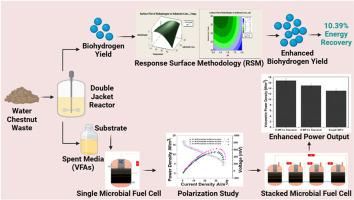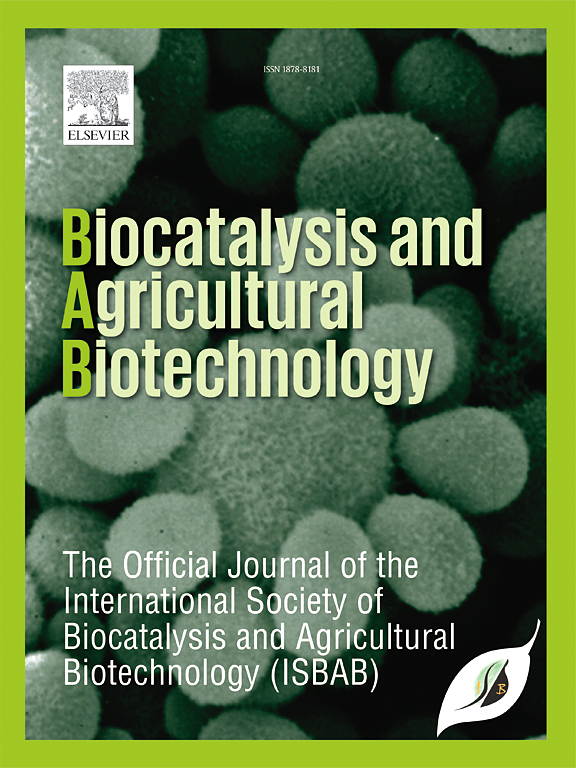Utilization of water chestnut waste for biohydrogen production and enhanced power generation by stacked microbial fuel cell
IF 3.8
Q2 BIOTECHNOLOGY & APPLIED MICROBIOLOGY
引用次数: 0
Abstract
A novel two-stage approach combining dark fermentation with microbial fuel cell (MFC) technology is proposed which enable biohydrogen production and bioelectricity generation from residual substrate energy. In the present study, batch fermentation of water chestnut waste using Enterobacter aerogenes (MTCC 2822) resulted in the production of biohydrogen. In the batch process, the highest production was 3.2 L/L. Further, single-parameter optimization and multi-parameter optimization were conducted via Response Surface Methodology (RSM) using the Central Composite Design (CCD) model. The maximum biohydrogen reached 3.44 g/L with 55% COD removal. The biohydrogen yield was 7.163 g H2/kg CODreduced with a maximum production rate of 712 mL/L/h. Further, the waste fermentation medium or spent media was used as a substrate in a Microbial Fuel Cell (MFC) to produce power using Pseudomonas aeruginosa PA1_NCHU as inoculum. MFCs were operated with various concentrations of phosphate buffer in the anolyte. As the output is limited in a single MFC, MFCs were operated in parallel stacks to increase power output. A maximum of 28% increase in the power density was observed in stacked MFCs. The energy recovered from the dark fermentation process was around 10.39% and a single MFC was around 10.67%. Hence, this study highlights the innovative use of agricultural waste and the effective combination of dark fermentation with stacked MFC, presenting a sustainable method of maximizing biohydrogen production and bioelectricity from spent media. By leveraging stacked MFC configuration, the potential of higher power output is demonstrated, underscoring the significance of this integrated system for energy recovery.

利用荸荠废弃物生产生物氢并通过叠层微生物燃料电池提高发电量
本研究提出了一种结合暗发酵和微生物燃料电池(MFC)技术的两阶段新方法,可利用残余基质能量生产生物氢和生物电。在本研究中,利用产气肠杆菌(MTCC 2822)对荸荠废料进行批量发酵,生产出生物氢。在批处理过程中,最高产量为 3.2 升/升。此外,还通过响应面法(RSM)使用中央复合设计(CCD)模型进行了单参数优化和多参数优化。最大生物氢达到 3.44 克/升,COD 去除率为 55%。生物氢产量为 7.163 g H2/kg CODreduced,最大生产率为 712 mL/L/h。此外,废物发酵培养基或废培养基被用作微生物燃料电池(MFC)的底物,以铜绿假单胞菌 PA1_NCHU 为接种体进行发电。MFC 在不同浓度的磷酸盐缓冲液中运行。由于单个 MFC 的输出功率有限,因此将 MFC 并联堆叠运行以增加功率输出。在堆叠的 MFC 中,功率密度最多增加了 28%。暗发酵过程的能量回收率约为 10.39%,而单个 MFC 的能量回收率约为 10.67%。因此,这项研究强调了对农业废弃物的创新利用,以及暗发酵与堆叠式 MFC 的有效结合,提出了一种从废弃介质中最大限度地生产生物氢和生物电的可持续方法。通过利用堆叠式 MFC 配置,展示了更高功率输出的潜力,强调了这一综合系统对能源回收的重要意义。
本文章由计算机程序翻译,如有差异,请以英文原文为准。
求助全文
约1分钟内获得全文
求助全文
来源期刊

Biocatalysis and agricultural biotechnology
Agricultural and Biological Sciences-Agronomy and Crop Science
CiteScore
7.70
自引率
2.50%
发文量
308
审稿时长
48 days
期刊介绍:
Biocatalysis and Agricultural Biotechnology is the official journal of the International Society of Biocatalysis and Agricultural Biotechnology (ISBAB). The journal publishes high quality articles especially in the science and technology of biocatalysis, bioprocesses, agricultural biotechnology, biomedical biotechnology, and, if appropriate, from other related areas of biotechnology. The journal will publish peer-reviewed basic and applied research papers, authoritative reviews, and feature articles. The scope of the journal encompasses the research, industrial, and commercial aspects of biotechnology, including the areas of: biocatalysis; bioprocesses; food and agriculture; genetic engineering; molecular biology; healthcare and pharmaceuticals; biofuels; genomics; nanotechnology; environment and biodiversity; and bioremediation.
 求助内容:
求助内容: 应助结果提醒方式:
应助结果提醒方式:


